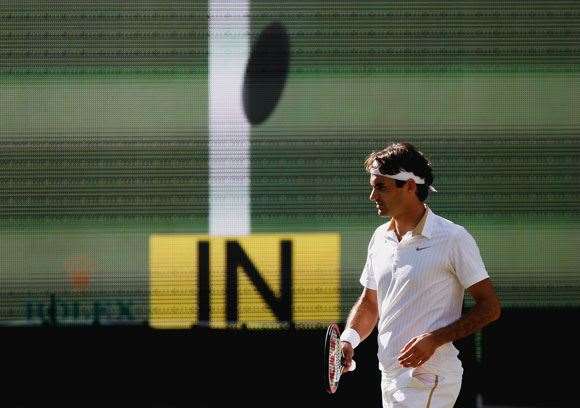For athletes, the “how” and “why” of what they do is no longer a mystery.
For athletes, the “how” and “why” of what they do is no longer a mystery.Cricket and tennis stars would criticise Hawk-Eye’s technology more if it wasn’t such a handy training tool.
 Getty Images
Getty ImagesIt’s controversial. It never ceases to give Roger Federer and Rafael Nadal fits. No one’s absolutely sure whether it gets those LBW decisions right. But Hawk-Eye has most people convinced – and it’s here to stay. In at least two sports, cricket and tennis, it has become integral to the adjudication of close decisions.
Hawk-Eye was developed by a team of engineers at Roke Manor Research Ltd at Romsey, Hampshire, in the UK. Before it became wholly owned by Siemens, then passed on to the Chemring Group in 2010, Roke Manor was famous for developing such innovations as memory systems for supercomputers, acoustic locations systems for weapons and land mines, and the world’s first monolithic gallium arsenide microwave circuit. When it turned its attention to sport it quickly
and quietly revolutionised it ‒ and the way sport is telecast.
If we had to put names to this innovation, these would be Paul Hawkins and David Sherry. Both of Roke Manor, they submitted the original patent for the Hawk-Eye invention in 2001, originally titled “Video Processor Systems for Ball Tracking in Ball Games”.
Based on mathematical principles of triangulation, Hawk-Eye is, simply put, a system that tracks the trajectory of a ball through the use of several strategically placed high-speed cameras, then records its most statistically likely path. It then renders this path as a moving 3D image. That’s the image you see when there’s an appeal for an LBW in cricket or a query over a close call in tennis.
The innovation is quickly taking hold. Apart from its status as an almost-indispensable fixture in tennis and cricket, it’s been used in snooker broadcasts, is being further developed for soccer and Gaelic football, and ‒ utilising its two main elements of tracking system and video replay system ‒ is increasingly being seen as a valuable coaching tool.
Cricketers have reason to curse and commend the system. Though they might not agree with the odd LBW decision (remember the media outcry over a not-out granted to Andrew Symonds facing a hat-trick-chasing Anil Kumble in 2008 after a Hawk-Eye judgement that any naked eye could see was in error?), they are able to use the data it records, such as speed and deviation of the ball and biomechanical information to adjust technique. Batsmen are able to access the complete record of balls bowled and analyse which deliveries they were most likely to score from. Since quick graphic Hawk-Eye-based summaries (such as the grouping of a bowler’s deliveries) have been used on telecasts, viewers have become more informed than ever before.
The system has become so sophisticated that it now allows athletes to review their own performance with ease via Interactive Video Replay Touch Screen monitors. Hawk-Eye’s Tennis Coaching System allows players in practice access to analysis of strokes, rallies and match play. This means that, for athletes, the “how” and “why” of what they do is no longer a mystery.
The introduction of Hawk-Eye moved quickly from viewer orientation to incorporation into the game itself. It was introduced into cricket in 2001. By 2008-9 it was approved by the ICC for use by third umpires to adjudicate decisions. It took a loss for the vociferous Serena Williams in a US Open match against Jennifer Capriati in 2004 for tennis to consider the new technology. In 2006, after being trialled in the Hopman Cup, it was introduced at the same tournament, along with the “challenge” system.
Most of the protests around the use of Hawk-Eye in cricket revolve around its ability to accurately plot the trajectory of a ball after bouncing, given other variables such as pitch conditions and deviation. Certainly, there is some doubt when the ball’s journey between pitch and pad is too short to allow for the production of the three frames needed to accurately plot a curve and determine an LBW verdict. In tennis the issues are even more complex and mainly relate to distortion of the ball upon impact, which can be a crucial factor in close line calls. About one of its decisions – a line call that put him out of a tournament – Nadal once claimed there wouldn’t have been a problem had it been on clay, as the impression left by the ball would have been clearly visible.
Still, overall, the invention of Hawk-Eye has made adjudication of both tennis and cricket matches easier for officials and more viewer-friendly for television audiences. It has certainly had the beneficial effect of quelching querulous tennis players, many of whom, in their never-ending quest to irritate spectators, have been forced to resort to grunting over groaning. Fortunately for its inventors, Hawk-Eye was introduced at the right time in history. Two decades earlier and it might not have survived its most formidable threat: the evil genius of John McEnroe.
‒ Robert Drane
Related Articles

Feature Story: Moving the Needle

The Aussies at The Open













